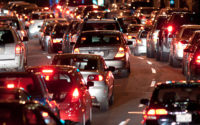Who stands to benefit from vote-by-mail?
Article by Ethan Kable.
Could COVID-19 reshape the electoral outcome this November? Research from the Lowe Institute shows that it might, depending on how states adjust voting procedures.
As the threat of COVID-19 persists, one of the biggest questions facing US policymakers is how to adapt voting procedures for the upcoming presidential election. Concerns over the safety of in-person voting has led to more calls for increased access to vote-by-mail (VBM) or absentee ballot options. Predictably, the specter of making significant changes to state voting policy has caused many to ask the question: who stands to benefit from greater access to VBM?
In early April, VBM initiatives enjoyed cross-party support. According to a Reuters/Ipsos poll, 79% of Democrats and 65% of Republicans favored expanding access to VBM, and both red and blue states have adjusted current voting rules to allow residents who feel unsafe going to polls to receive an absentee ballot.
But by May, the issue of VBM had fallen prey to the right-left divide that characterizes so many policy issues in the US. President Trump advanced theories connecting VBM to voter fraud (which is largely unfounded) and there was a subsequent shift in partisan opinion on the matter. The same Reutuers/Ipsos poll conducted in late May found that while Democratic support for VBM remained high at 83%, Republican support plummeted to 43%.
Though fear of voter fraud is the stated reason for many Republicans’ opposition to increasing access to VBM, the implicit fear is that VBM will disproportionately enfranchise Democratic voters. In short, Republicans believe that VBM will benefit Democrats more than Republicans. But the jury is still out on this claim, with evidence pointing in both directions.
A recent study of VBM in Colorado found that mailing all residents a paper ballot significantly increased voter turnout. The percent change in turnout was greatest among groups that tend to vote less frequently, such as African-American voters (+13 points), voters without a high school diploma (+9.6 points), young voters, and poorer blue-collar voters. The study notes that while in theory the demographic groups that saw higher levels of turnout tend to lean more Democratic, Colorado Democrats and Republicans each benefitted by +8 percentage points of turnout.
However, a consumer sentiment survey conducted by the Lowe Institute during the week of May 11-18 might hint at different results. 1,000 respondents from primarily Southern California were surveyed on a range of questions regarding how their attitudes and actions toward a variety of activities have changed with the novel coronavirus. One question asked respondents “Would you currently feel safe enough to vote at a polling station?” The below graph shows the distribution of responses among all respondents.
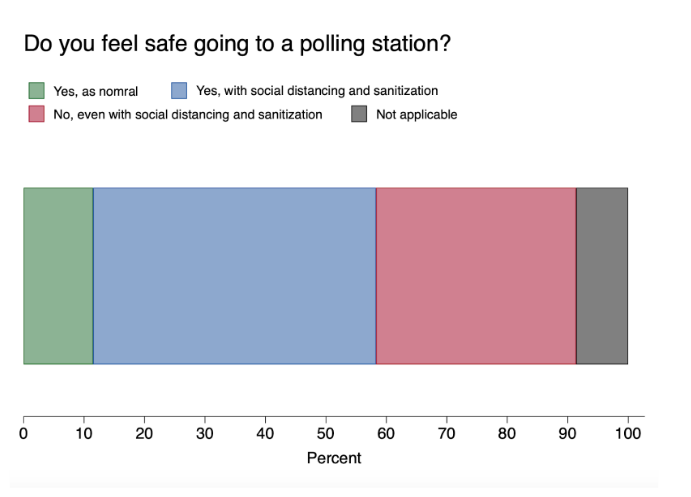
11.5% of respondents said they felt comfortable going to polls as normal, whereas 46.8% of respondents only felt comfortable going if social distancing and sanitization were in place. Perhaps most notably, 33.1% of respondents said they wouldn’t feel safe going to the polls even with best practices in place. Presumably, it is the group of respondents who don’t feel safe going to the polls who would benefit most from access to VBM as they are the group least likely to vote in person if the threat of COVID-19 lingers until election day. Thus it is important to understand who is more or less likely to vote in person.
There is a noticeable split in comfort level of going to a polling station according to gender. Whereas 14.9% of men feel safe going to a polling station as normal, only 8.8% of women do. Conversely, only 26.4% of men don’t feel safe voting in person even if proper measures are in place whereas 38.8% feel similarly.
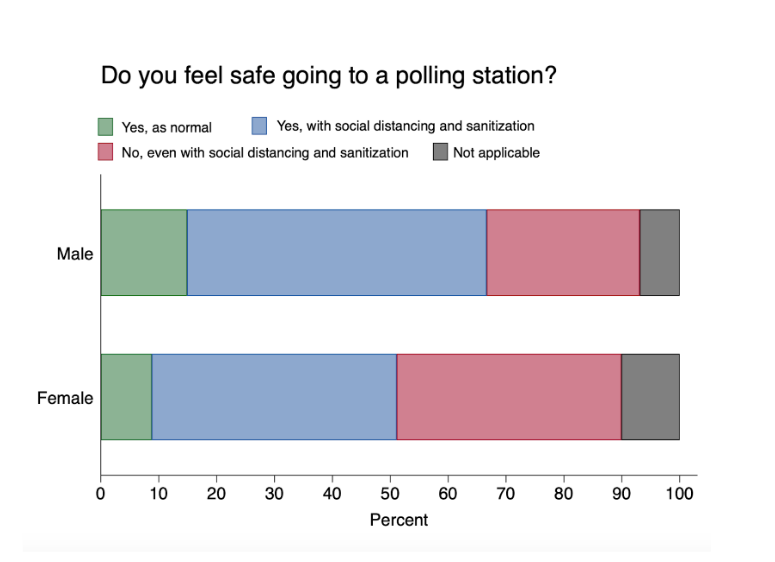
Somewhat surprisingly, there isn’t a similarly large split in attitude vis-à-vis in-person voting according to age. Though older individuals are much more vulnerable to the virus, respondents in the 65+ age bracket did not demonstrate a significantly larger concern toward the safety of voting at a polling station. Respondent income bracket had a similarly negligible impact on attitude toward going to vote at a polling station.
Perhaps unsurprisingly, the strongest predictor of attitudes towards voting in person was partisan identification. We observed a strong partisan split whereby those who held a favorable attitude toward President Trump felt safer voting at polling station, even without best practices in place, and those who held unfavorable attitudes toward President Trump felt less safe voting in person, even with best practices in place.
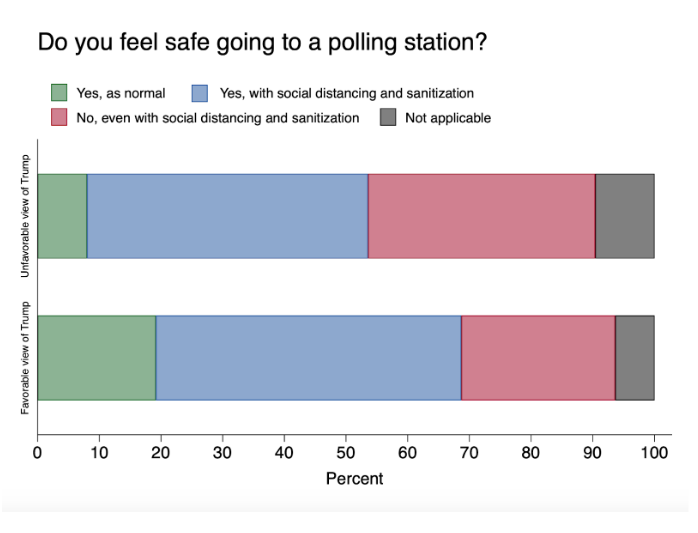
Other research has shown why this partisan split in perception may exist, and it comes down to your source of information. For example, one study published by the Pew research center found that perceptions of COVID-19 vary depending on the cable news channel that viewer watches. Viewers of CNN and other left-leaning news sources systematically perceived COVID-19 to be a more serious threat than those whose primary source of news was Fox News or other right-leaning cable channels.
Data from the Lowe Institute survey corroborates these findings. Overall, there was a leftward skew in respondents, with 301 listing CNN as their number one primary news source, and only 110 listing Fox News as their number one primary news source. However, among respondents who said they feel safe attending a polling station in person even without social distancing and sanitization, 25.2% listed Fox News as their primary news source and 24.3% listed CNN. Among those who said they wouldn’t feel safe voting at a polling station even with these best practices in place, 31.4% listed CNN as their primary news source and only 7.6% listed Fox News.
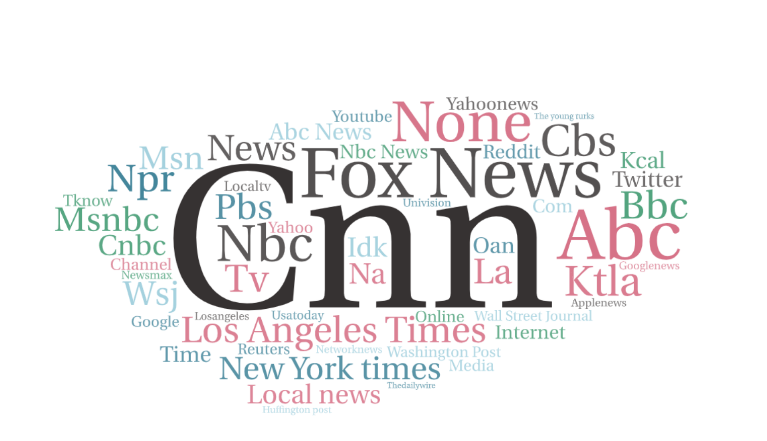
Word cloud of primary news sources among all survey respondents
The partisan divide on perceived threat of COVID-19 at polling stations witnessed in the Lowe Institute survey indicates that VBM may disproportionately benefit Democrats. Those who oppose President Trump and support the Democratic party are more likely to feel unsafe voting at a polling station, and thus would potentially turn out for in-person voting in lower numbers in November than their Trump supporting counterparts.
It should be noted that there are limitations to this analysis. Given the highly contentious nature of the upcoming election, voters may feel it’s worth forgoing a perceived sense of danger in order to vote. Though a voter may have indicated they don’t feel safe even if proper social distancing and sanitization was implemented at the polling station, they may go vote in person anyway.
COVID-19 could have a major electoral impact this November. In states that fail to implement VBM, some votes will prioritize perceived safety over civic duty. In states that implement VBM, some voters who would otherwise have been unable to go to the polls even in a normal year will now be able to vote. COVID-19 will cause a shift in the composition of the electorate no matter how a state chooses to respond.

